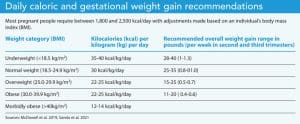Early identification aids proper management.
CNE: 1.5 contact Hours
Learning Objectives:
- Describe causes and risk factors of gestational diabetes mellitus (GDM) and associated maternal complications and fetal risks.
- Discuss diagnosis and screening for GDM.
- Describe how patients can manage GDM with lifestyle modifications, including self-monitoring of glucose, diet and exercise recommendations, and pharmacologic treatments when necessary.
The authors and planners of this CNE activity have disclosed no relevant financial relationships with any commercial companies pertaining to this activity. See the last page of the article to learn how to earn CNE credit.
Expiration: 8/1/25
Takeaways:
- Gestational diabetes mellitus (GDM) frequently represents pre-existing hyperglycemia and is indicative of underlying β-cell dysfunction.
- Lifestyle modification is the gold standard for the care of those with GDM.
- Approximately 15% to 30% of women with will require pharmacologic interventions along with diet and exercise to attain glycemic targets during pregnancy.
- GDM may be mitigated if diet, exercise, and lifestyle modification are implemented early in pregnancy (within the first trimester or early in the second).
Gestational diabetes mellitus (GDM) refers to any degree of glucose intolerance that starts or is first recognized during pregnancy. Frequently, GDM represents pre-existing hyperglycemia and indicates underlying β-cell dysfunction and insulin resistance. According to the International Diabetes Federation, 84% of the 20 million pregnant people worldwide with hyperglycemia have GDM. A report released by the Centers for Disease Control and Prevention on July 19, 2022 states that the overall GDM rate in the United States is 7.8 per 100 births, an increase of 30% from 2016 to 2020. Experts anticipate that this growing public health concern will increase in response to more people with hyperglycemia, diabetes, obesity, advanced maternal age, and sedentary lifestyles.
GDM pathophysiology
To facilitate a developing fetus’ nutrient needs, glucose regulation and insulin sensitivity change throughout normal pregnancy depending on need. For example, it increases early in the pregnancy to promote adipose stores for energy demands later. As the pregnancy progresses, placental hormones promote insulin resistance. In the last trimester, basal endogenous glucose increases by up to a third and fat stores break down. This elevates blood glucose and free fatty acid concentrations; glucose is then transported across the placenta to the growing fetus. In mothers who don’t have GDM, the pancreas adapts by producing more insulin (by hyperplasia of the pancreatic β-cells and secretion of glucose-stimulated insulin), normalizing blood glucose. The mother’s insulin sensitivity returns to normal levels shortly after birth, suggesting that placental hormones mediate this process.
In those with GDM, the pancreas fails to respond adequately to pregnancy changes, mirroring the insulin resistance and response seen in individuals with type 2 diabetes. During late pregnancy, over half of women, those with GDM and those with normal glucose tolerance, demonstrate reduced insulin sensitivity. Pregnancy can expose a previously unknown β-cell incompetency.
GDM risk factors
Patients may have modifiable and nonmodifiable GDM risk factors.
Modifiable risk factors
Understanding modifiable GDM risk factors can help prevent and limit its prevalence and improve clinical outcomes. Modifiable risk factors include obesity, a pre-pregnancy body mass index (BMI) >30 kg/m2, excessive gestational weight gain, and diet. Western diets that include sugar-sweetened beverages, fried foods, red meat, and processed grains have been shown to contribute to GDM risk. However, Mediterranean diets high in fruits, green leafy vegetables, poultry, fish, nuts, and fiber have been shown to decrease that risk. Cigarette smoking also has been linked to increased GDM risk.
According to Zhang and colleagues, increased physical activity before and during pregnancy has been shown to lower the risk of GDM development by 20% to 50%. In addition, pre-pregnancy health habits—such as healthy weight, diet, and physical activity—have been shown to decrease the risk by more than 45%.
Nonmodifiable risk factors
Nonmodifiable risk factors include ethnicity (especially among South Asian, East Asian, Middle Eastern, African American, Hispanic American, Native American, Native Hawaiian, Alaska Native, Pacific Islander, and Caribbean populations), advanced maternal age (over 35 years), family history of diabetes, previous GDM, and first-degree relatives with a history of type 2 diabetes.
Other nonmodifiable risk factors include insulin resistance, such as metabolic syndrome and polycystic ovarian syndrome, and undiagnosed diabetes. Studies conducted by Johns and colleagues and Yuen and colleagues, in response to the high prevalence of type 2 diabetes in women with GDM, found specific genetic variations associated with ethnicity. When more than one of the identified alleles are present, GDM risk increases. These genes have been linked to a risk of GDM and type 2 diabetes. Research in this area continues.
Genetic research conducted by Johns and colleagues has identified the intrauterine environment as a risk factor. People who develop GDM have a 33% incidence of a mother with diabetes and no diabetes history in the father. For those with no maternal or paternal diabetes history, the incidence is 6%. Smaller studies that have examined siblings born before and after the mother developed type 2 diabetes found that those born after the diagnosis had a significantly increased risk of developing type 2 diabetes. Researchers continue their work in this area.
Maternal complications and fetal risks
The most common fetal risks of GDM include macrosomia, preterm birth, birth trauma (including shoulder dystocia), polycythemia, neonatal hypoglycemia, and respiratory distress. A recent study by Plows and colleagues indicates the possibility of increased risk of insulin resistance, prediabetes/diabetes, metabolic syndrome, high BMI, obesity, high systolic blood pressure, and circulatory diseases. Some evidence suggests an increased risk of stillbirth.
People with GDM have an increased risk for pregnancy and birth complications, including gestational hypertension, pre-eclampsia, infection, polyhydramnios, birth trauma, assisted vaginal birth (forceps or vacuum), and cesarean birth. The mother also is at increased risk for developing antenatal depression.
A GDM diagnosis increases the risk of developing type 2 diabetes 10-fold. These patients also are at risk of recurrent GDM in subsequent pregnancies. In addition, GDM increases cardiovascular disease risk by 63%, which may be related to a combination of weight and diabetes. Although no predictors have been identified, higher fasting glucose levels on oral glucose tolerance tests, increased maternal BMI, and early gestational age at GDM diagnosis seem to correlate with future type 2 diabetes. These risks to the child and mother make addressing preventable GDM risk factors essential in every pregnancy.
Diagnosis
Currently, no universal standard exists for screening and diagnosing GDM, but most providers use one of two methods. The one-step method involves administering a 2-hour glucose tolerance test after a fasting individual consumes a 75-gram oral glucose load. An elevated blood plasma level results in a positive GDM diagnosis. The two-step method starts with a 1-hour glucose challenge test in which a nonfasting person consumes a 50-gram glucose drink and the blood plasma level is measured 1 hour later. Those with an elevated value move to step two, which measures blood glucose at 1, 2, and 3 hours. If both values are elevated, a diagnosis of GDM is made. (See Two-step screening.)
Two-step screening
Use a single 2-hour fasting glucose tolerance test to diagnose gestational diabetes mellitus (GDM) or the following two-step method:
Step one
- At 24 to 28 weeks’ gestation, administer a 50-gram glucose drink to the nonfasting patient who hasn’t previously been diagnosed with DM.
- After 1 hour, measure the patient’s blood glucose.
- If blood glucose is ≥130, 135, or 140 mg/dL (depending on which guidelines your organization is following), proceed to step two.
Step two
- Administer a 100-gram glucose drink to the fasting patient.
- Blood glucose is measured at 1, 2, and 3 hours. GDM is diagnosed if at least two of the measures are elevated.
- Fasting: ≥95 mg/dL
- 1h: ≥180 mg/ dL
- 2h: ≥155 mg/dL
- 3h: ≥140 mg/dL
Source: American Diabetes Association
The American College of Obstetricians and Gynecologists (ACOG) recommends the two-step method, whereas the International Association of the Diabetes and Pregnancy Study Groups and the World Health Organization recommend the one-step method. The American Diabetes Association (ADA) recommends either method.
Managing GDM
Early diagnosis and therapeutic intervention aid adverse outcome prevention for the mother and fetus. After diagnosis, most patients should be referred for diabetes self-management education (DSME) and receive care from an interprofessional team. Lifestyle modification is the gold standard for care. Treatment typically begins with medical nutrition therapy (MNT), physical activity, and weight management. Approximately 70% to 85% of patients attain glycemic targets with diet and exercise alone. (See Glycemic targets.)
Glycemic targets
The American Diabetes Association recommends the following glycemic targets for pregnant patients:
- Fasting blood glucose: <95 mg/dL
- 1 hour after eating: <140 mg/dL
- 2 hours after eating: <120 mg/dL
- A1C <6% (This will be lower in pregnancy due to red blood cell turnover. If the patient has hypoglycemia, the target may be <7%.)
Education
Multidimensional DSME includes blood glucose monitoring (glucose meter use and interpretation), healthy eating, physical activity, medication adherence, and healthy coping strategies. Nurses, dieticians, and pharmacists typically provide this education. These diabetes care and education specialists work alongside other members of the interprofessional team to provide education and support during pregnancy and after birth.
Monitoring
Patients with GDM will learn how to self-monitor their blood glucose levels. In most cases, the patient tests fasting blood glucose and 1 to 2 hours after eating. Patients should keep their desired glycemic targets in mind when interpreting results.
Pregnant women with type 1 diabetes who use continuous glucose monitoring (CGM) have shown improved glycated hemoglobin (HbA1C) levels and decreased episodes of hypoglycemia. Yu and colleagues conducted a systematic review of 29 studies examining the use of CGM in patients with GDM. They found that CGM increased the detection of glycemic variability. The review also noted that using CGM leads to more treatment adjustments and less gestational weight gain. (For more information about CGM, visit myamericannurse.com/cgm-continuous-glucose-monitoring.)
Diet
Typically, GDM is diagnosed between 24 and 28 weeks’ gestation when many pregnant people have already established the practice of “eating for two.” They’re operating under the premise that weight gain is expected. However, weight gain during pregnancy should be sufficient only to maintain the fetus’ growth and development. Excessive weight gain is associated with babies who are large for their gestational age, increased cesarean birth, hypertensive disorders, and postpartum weight retention. Recommendations state that individuals with GDM who have obesity or have gained the desired amount of weight should be placed on caloric restrictions of 30%–33%. Adherence to these dietary plans has been associated with lower HbA1C, less weight gain, and appropriate fetal growth. (See Daily caloric and gestational weight gain recommendations.)


Caloric intake and weight gain must be carefully monitored in patients with GDM. Working with a registered dietician, the patient can develop a dietary plan that incorporates their BMI. Just as no diabetic diet exists, no set optimal caloric goal for those with GDM exists. Dietary plans should be adjusted based on self-monitored blood glucose results, weight gain, appetite, dietary preferences, and activity level. Dietary goals should provide adequate caloric intake, promote maternal and fetal health, support appropriate weight gain, and ensure meeting glycemic targets. (See GDM dietary recommendations.)
GDM dietary recommendations
According to the American Diabetes Association and Rasmussen and colleagues, overall dietary recommendations for women with gestational diabetes mellitus (GDM) are similar to those with normal blood glucose. Ideally, they should eat three main meals and two to three snacks per day, with a smaller meal (approximately 30 grams of carbohydrates) at breakfast. Polyunsaturated fatty acids, which are anti-inflammatory, aid development of the fetus’ immune, vascular, and visual systems. High-fiber diets slow glucose absorption, reducing demand on β-cells. Most women can get the recommended amount of fiber from fibrous vegetables as well as pasta, rice, and whole wheat bread. Although foods with a low-glycemic index appear to be beneficial for managing GDM, they have no effect on primary neonatal outcomes.
Physical activity
Physical activity can help patients attain glycemic goals. Patients who were physically active before being diagnosed with GDM should continue to exercise with modifications as medically indicated. Recommendations include maintaining the same exercise goals set for people with type 2 diabetes (150 minutes of moderate-intensity exercise per week), daily 30-minute walks (particularly after meals) or a total of 1 hour per day, or 40 to 60 minutes of exercise three times a week. No true consensus exists as to what type of exercise and at what intensity are optimal, but physical activity has some effect on lowering blood glucose levels. For example, 15 to 20 minutes of moderate-intensity walking can potentially lower blood glucose levels 20 to 40 mg/dL.
Providers should evaluate a patient’s pre-existing cardiovascular or musculoskeletal conditions before they engage in physical activity. In addition, patients with pelvic joint laxity, short cervix conditions, or those at risk for premature delivery should seek advice from their provider and proceed with caution.
Pharmacologic interventions
Approximately 15% to 30% of patients with GDM will require pharmacologic intervention in addition to diet and exercise to attain glycemic targets during pregnancy. Medications include insulin and oral antihyperglycemic agents.
Insulin
The ADA and ACOG recommend insulin as the first-line medication for treating GDM. The currently available human insulin formulations don’t cross the placenta and allow for individualized treatment. Patients who require insulin therapy should be referred to an endocrinologist, a maternal fetal medicine specialist, or a provider experienced in treating diabetes in pregnancy.
Insulin can be administered via multiple daily injections or continuous insulin infusion via an insulin pump. Neither method has been found to be superior to the other. The most common complication associated with insulin therapy is hypoglycemia. Anyone prescribed insulin should be taught the signs and symptoms of hypoglycemia and how to treat it.
Oral antihyperglycemic agents
The U.S. Food and Drug administration hasn’t approved any oral antihyperglycemic agents for treating GDM. However, metformin and glyburide (Category B drugs with no adequate studies done in pregnant subjects) may be prescribed for those who choose not to take insulin, can’t afford it, or can’t safely manage it. Both drugs cross the placenta. Glyburide has been associated with increased incidence of macrosomia and neonatal hypoglycemia, and metformin may increase the risk of premature birth and lead to higher BMI and obesity in offspring. The ADA also cautions against the use of metformin in patients with pre-eclampsia, hypertension, or those at risk for fetal growth restriction.
Postpartum GDM management
Anyone with a history of GDM should be tested for diabetes 4 to 12 weeks’ postpartum using an oral glucose tolerance test rather than HbA1C, which could be falsely lowered as a result of increased red blood cell turnover during pregnancy. Testing should continue every 1 to 3 years, keeping in mind that those who experience GDM during pregnancy are at a 50% to 60% increased risk for developing type 2 diabetes.
Early identification and management
Implementation of proper diet, exercise, and lifestyle modifications in the first or early second trimester of pregnancy can mitigate GDM. The keys to proper care and management include early identification, an interprofessional team approach, and appropriate follow-up testing for persistent hyperglycemia and type 2 diabetes.
The authors are assistant professors at the University of Texas Cizik School of Nursing in Houston.
References
American College of Obstetricians and Gynecologists. ACOG Practice Bulletin No. 190: Gestational diabetes mellitus. Obstet Gynecol. 2018;131(2):e49-64. doi:10.1097/AOG.0000000000002501
American Diabetes Association. 14. Management of Diabetes in Pregnancy: Standards of Medical Care in Diabetes—2021. Diabetes Care. 2021;44(Suppl 1);S200-10. doi:10.2337/dc21-S014
Berberoglu, Z. Pathophysiology of gestational diabetes mellitus. Eur Med J Diab. 2019;7(1):97-106.
Casagrande SS, Linder B, Cowie CC. Prevalence of gestational diabetes and subsequent type 2 diabetes among U.S. women. Diabetes Res Clin Pract. 2018;141:200-8. doi:10.1016/j.diabres.2018.05.010
Gregory ECW, Ely DM. Trends and characteristics in gestational diabetes: United States, 2016-2020. National Vital Statistics Report. July 19, 2022.
Han S, Middleton P, Shepherd E, Van Ryswyk E, Crowther CA. Different types of dietary advice for women with gestational diabetes mellitus. Cochrane Database Syst Rev. 2017;2(2):CD009275. doi:10.1002/14651858.CD009275.pub3
International Diabetes Federation. IDF Diabetes Atlas Ninth Edition. 2019.
Johns EC, Denison FC, Norman JE, Reynolds RM. Gestational diabetes mellitus: Mechanisms, treatment, and complications. Trends Endocrinol Metab. 2018;29(11):743-54. doi:10.1016/j.tem.2018.09.004
Lende M, Rijhsinghani A. Gestational diabetes: Overview with emphasis on medical management. Int J Environ Res Public Health. 2020;17(24)9573. doi:10.3390/ijerph17249573
McDowell M, Cain MA, Brumley J. Excessive gestational weight gain. J Midwifery Women’s Health. 2019;64(1):46-54. doi:10.1111/jmwh.12927
Mensah GP, ten Ham-Baloyi W, van Rooyen DRM, Jardien-Baboo S. Guidelines for the nursing management of gestational diabetes mellitus: An integrative literature review. Nurs Open. 2019;7(1):78-90. doi:10.1002/nop2.324
Plows JF, Stanley JL, Baker PN, Reynolds CM, Vickers MH. The pathophysiology of gestational diabetes. Int J Mol Sci. 2018;19(11):3342. doi:10.3390/ijms19113342
Rasmussen L, Poulsen CW, Kampmann U, Smedegaard SB, Ovesen PG, Fuglsang J. Diet and healthy lifestyle in the management of gestational diabetes mellitus. Nutrients. 2020;12(10):3050. doi:10.3390/nu12103050
Saeedi M, Cao Y, Fadl H, Gustafson H, Simmons D. Increasing prevalence of gestational diabetes mellitus when implementing the IADPSG criteria: A systematic review and meta-analysis. Diabetes Res Clin Pract. 2021;172:108642. doi:10.1016/j.diabres.2020.108642
Sandu C, Bica C, Salmen T, et al. Gestational diabetes—Modern management and therapeutic approach (Review). Exp Ther Med. 2021;21(1):81. doi:10.3892/etm.2020.9512
Yehl K. AADE practice paper in brief: Gestational diabetes mellitus. AADE in Practice. 2018;6(6):32-4. doi:10.1177/2325160318803148
Yu Q, Aris IM, Tan KH, Li L-J. Application and utility of continuous glucose monitoring in pregnancy: A systematic review. Front Endocrinol. 2019;10:697. doi:10.3389/fendo.2019.00697
Yuen L, Wong VW, Simmons D. Ethnic disparities in gestational diabetes. Curr Diab Rep. 2018;18(9):68. doi:10.1007/s11892-018-1040-2
Zhang C, Rawal S, Chong YS. Risk factors for gestational diabetes: Is prevention possible? Diabetologia. 2016;59(7):1385-90. doi:10.1007/s00125-016-3979-3
Zhou T, Sun D, Li X, et al. Prevalence and trends in gestational diabetes mellitus among women in the United States, 2006–2016. Diabetes. 2018;67(Suppl 1):121. doi:10.2337/db18-121-OR
Key words: Gestational diabetes, pregnancy, diabetes, hyperglycemia, glycemic targets, life-style modifications



















2 Comments. Leave new
The information in this course is useful and relevant to my practice.
Very interested